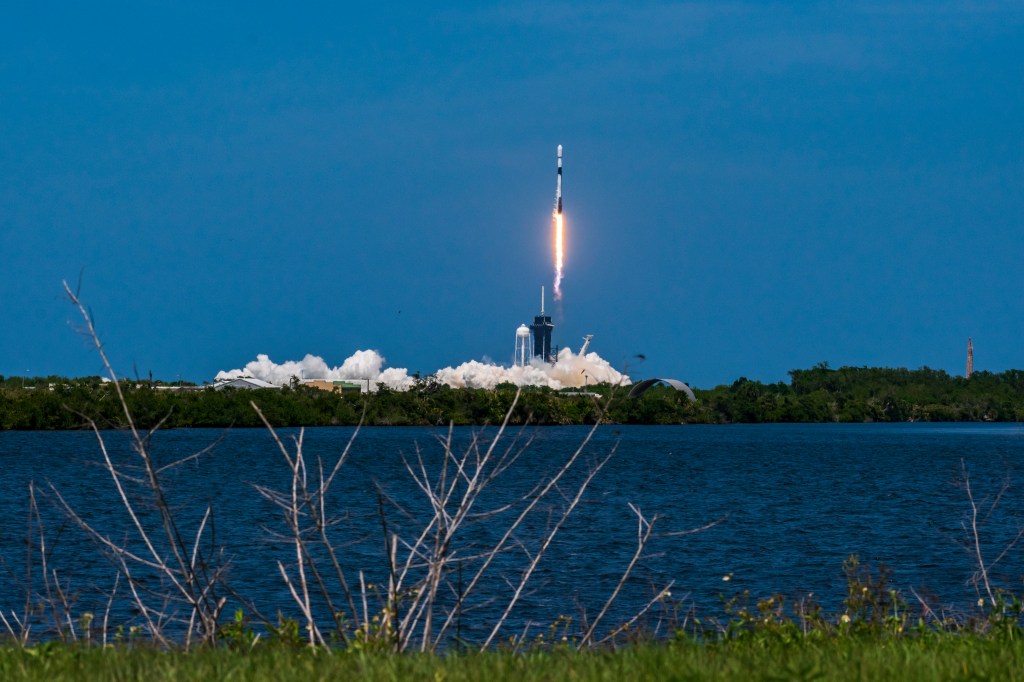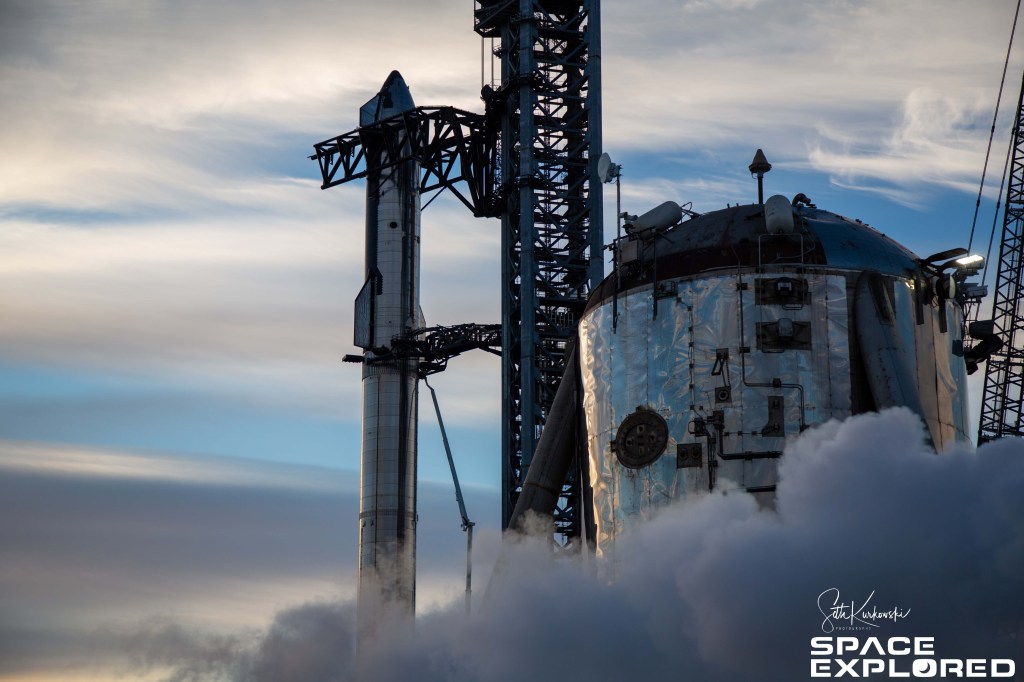
In a Tweet last year, Elon Musk confirmed that Starlink laser-based communication was coming to SpaceX’s Dragon capsule. Now we know the Polaris Dawn mission will be the first crew to test out and make use of this additional connectivity option. And as Starlink continues to expand, with plans for Gen2 Starlink satellites launched on Starship being essential for the company, NASA has expressed some concerns about the expanding constellation.
Table of contents
Starlink laser communication coming to Dragon Capsule
Inspiration4 was an amazing program to witness, as four citizens, not carefully selected NASA astronauts, went through the training to go spend a few days in space. The program was documented in a Netflix documentary, benefited St. Jude, and even performed some research in space. The Polaris Program seems set to crank all that up to 11.
While continuing to support St. Jude, Polaris Dawn will reach new heights (literally for Dragon), testing out new technologies and suits for the first time. SpaceX’s suits will be worn by the crew of four during launch, landing, and EVA. A spacewalk will be performed from the capsule, and a new Starlink laser-based connection should facilitate better, more continuous, and higher-speed communication.

One of the criticisms Inspiration4 received is that it wasn’t doing more to further human spaceflight, but now Inspiration4 seems like a stepping stone for Polaris, which is focused on many things that further SpaceX’s development in preparation for an eventual human trip to Mars. Another criticism Inspiration4 received was the short and minimal livesteam from space. While the documentary provided some of these views (and there will be another documentary with the Polaris Program), Inspiration4 was limited by the regular interruptions in connectivity preventing lengthy livestreams. The Starlink connection should help alleviate those issues, so I certainly hope we will get live views of the first spacewalk from Dragon.
Starlink concerns
I want to be clear, I am a fan of Starlink. Worldwide high-speed internet connectivity will go a long way in connecting the world, and Starlink is the first service that truly looks prepared to offer that. The people that really need Starlink (who are able to afford the rather expensive service) will reap the benefits of it, while those lucky enough to live somewhere with high-speed fiber internet may never even consider the service. Despite all of Starlink’s positive aspects, the negatives need to be considered too.
SpaceX, especially during the first ten launches of the Starlink program, made a lot of changes to address some of these concerns. But here are a few of the concerns raised over the Starlink program.
- Starlink satellites are very bright, disrupting astrophotography
- Many Starlink satellites interfere with scientific observations
- Starlink Gen1 satellites can only service so many people
- More satellites in orbit = more risk of collision / space junk
Disrupting Astrophotography
SpaceX tried to minimize the first two concerns with less reflective satellites, introduced on Starlink V1.0 L2, and with sunshades, introduced on Starlink V1.0 L7 (with wider deployment starting on Starlink V1.0 L9). This certainly helped, with the satellites far less visible, but it has not totally solved the problem of Starlink satellites getting in the way of scientific observation, and this will only get worse as more and more satellites are launched into orbit.
The limited number of people that the Starlink network can support is just a fact of the network. This will improve with Gen2 satellites, but it’s not like Starlink will totally take over for wired internet connections. There are numerous limitations of the network preventing the service from reaching any sort of widespread adoption in cities.
Collision Risk
Perhaps one of the most concerning risks of the Starlink network is just the pure number of satellites. There are a LOT of satellites. Having launched over 2,000 Starlink satellites, low Earth orbit has a night number of Starlink satellites already, and the problem will only get worse as more satellites are launched and other satellites constellations join LEO.
In order to combat collision risk, all Starlink satellites have an autonomous collision avoidance system, but this very system has drawn criticism, with other satellite operators essentially forced to trust that SpaceX’s system will work properly. There have not been any collisions with Starlink satellites, but there have been several “near misses” (by space standards).
Space Junk
In addition to the initial risk of collision, there is a coinciding risk caused by the space junk that could be produced by inoperable satellites or following a satellite collision. Many measures, passive and active, have been put in place to prevent space junk as a result of the Starlink satellite constellation. To start, Starlink satellites are deployed at a much lower than operational altitude. The air resistance at this altitude is still rather high, so the satellites need to quickly perform orbit-raising maneuvers to get to operation altitude, but this means any Starlink satellites that are Dead-On-Arrival will quickly reenter and burn up.

This very move just cost SpaceX a great deal recently, when the company lost 40 satellites just days after a launch due to a geomagnetic storm.
The preventative measures continue once the Starlink satellites are operational, as the satellite can actively deorbit itself should issues arise. Even barring that, being in low Earth orbit means the satellites’ orbits will naturally decay unless regularly maintained. This could take years, but it’s not decades or some indefinite period of time.
So Starlink clearly isn’t a perfect installation. While SpaceX has done what it can to minimize many risks, there are tradeoffs being made here. But NASA recently sent a letter to the FCC citing concern with SpaceX’s plans for Gen2 Starlink satellites.
NASA expressed concern over Starlink Gen2

With the increase in large constellation proposals to the FCC, NASA has concerns with the potential for a significant increase in the frequency of conjunction events and possible impacts to NASA’s science and human spaceflight missions. Consequently, NASA submits this letter for the purpose of providing a better understanding of NASA’s concerns with respect to its assets on -orbit, and to further mitigate the risk of collisions for the benefit of all involved. NASA wants to ensure that the deployment of the Starlink Gen 2 system is conducted prudently, in a manner that supports spaceflight safety and the long-term sustainability of the space environment.
SpaceX’s proposal for roughly 30,000 more objects in low Earth orbit that “have the potential to impact NASA operations and the safety of NASA assets.” NASA continues to cite the risks the expansion of the network would cause to both scientific and human spaceflight missions. (And human spaceflight missions are certainly picking up, with more tourist/commercial spaceflights than ever!)
Starlink’s impact on scientific observations
The plan for Starlink Gen2 satellites is expected to have a major negative impact on Hubble’s observing capabilities:
Around 8% of composite images captured by the Hubble telescope are impacted by satellites captured during exposures. The Hubble telescope is in an orbit at 535 km. This proposed Starlink license amendment includes 10,000 satellites in or above the orbital range of Hubble, a situation that could more than double the fraction of Hubble images degraded. Furthermore, degradation severity will increase as the orbital proximity of the obscuring Space-X Gen2 satellites in relation to Hubble decreases.
That is in addition to the streaks the satellites will cause, and are already causing, for ground-based observations.
Starlink’s impact on human spaceflight & other launches
NASA is also concerned with an increasing unavailability of safe launch windows, especially for missions requiring instantaneous or short launch windows, such as planetary missions like Europa Clipper, which would be significantly affected due to a lost launch opportunity.
Launches are already adjusted based on known objects in orbit, but the pure number of Gen2 satellites planned will make that planning harder. In addition to impacting launches, this will also impact spacecraft reentry.
The proposed volume of autonomously maneuvering satellites directly parked in common phasing altitudes could result in potential loss of launch/entry opportunities impacting science and utilization for ISS.
Increased collision risk
The application states that the collision risk with large objects is zero because each spacecraft can maneuver. Zero risk is possible for any single maneuverable spacecraft if the event is mitigated down to zero probability of collision (Pc). However, considering multiple independent constellations of tens of thousands of spacecraft and the expected increase in the number of close encounters over time, the assumption of zero risk from a system-level standpoint lacks statistical substantiation.
Working towards a resolution
While NASA certainly has taken issue with SpaceX’s plan, in favor of continuing to further scientific exploration and human spaceflight, the agency doesn’t just want to put a stop to it, instead, it wants to work with SpaceX to better understand the intricacies of the system and adjust from there.
In addition to the previous requests stated in this letter, NASA suggests that SpaceX work with NASA to demonstrate the proposed capability with increasing volumes of satellites prior to each successive launch so that it may troubleshoot any issues that arise and make adjustments, as necessary. This incremental approach would allow SpaceX to gradually prove their concept of operations and troubleshoot any issues that arise along the way.
The letter ends telling SpaceX and others to Just Read the Instructions:
NASA would encourage all spacecraft operators, especially those contemplating large constellations, to consult the NASA Spacecraft Conjunction Assessment and Collision Avoidance Best Practices Handbook (https://nodis3.gsfc.nasa.gov/OCE_docs/OCE_51.pdf ). The handbook addresses various topics related to effective and mature conjunction assessment practices supporting a safe space environment for all operators. Space operators can use the handbook to benchmark their existing practice or in support of establishing an effective conjunction assessment capability. Many of the topics covered in the handbook are pertinent to the items above and may be a resource for SpaceX in addition to any feedback on the filing.
FTC: We use income earning auto affiliate links. More.



Comments